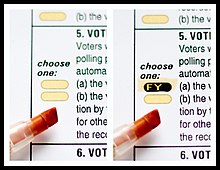Scantegrity
| Part of thePolitics series |
| Voting |
|---|
|
|
Scantegrityis a security enhancement foroptical scan voting systems,providing such systems withend-to-end (E2E)verifiability of election results. It uses confirmation codes to allow a voter to prove to themselves that their ballot is included unmodified in the final tally. The codes are privacy-preserving and offer no proof of which candidate a voter voted for. Receipts can be safely shown without compromising ballot secrecy.[1]
Scantegrity IIprints the confirmation codes ininvisible inkto improve usability and dispute resolution. As the system relies on cryptographic techniques, the ability to validate an election outcome is bothsoftware independentas well as independent of faults in the physicalchain-of-custodyof the paper ballots. The system was developed by a team of researchers including cryptographersDavid ChaumandRon Rivest.
Advantages
[edit]Optical scan voting systemsproduce an electronictally,while maintaining the original paper ballots which can be rescanned or manually hand-counted to provide an ostensibly corroborative tally. However, the correctness of each of these tallies requires the voter to either trust that the software is error-free and has not been hacked, or that the physical chain-of-custody of the ballots has not been broken at any point.[2]Other E2E voting systems such asPunchscanandThreeBallot,address these issues but require existing polling place equipment and procedures to be greatly altered or replaced.[3]In contrast, Scantegrity is anadd-onmeant to be used in conjunction with existing optical scan equipment, thereby requiring fewer hardware and software and procedural modifications.[1]
For all other voters, the ballot marking procedure is essentially identical to conventional optical scan paper-ballots. Similarly, the underlying system still produces both an electronic tally as well as a human readablepaper trailthrough whichmanual recountscan still be conducted.
Method
[edit]
Left:Unmarked optical scan bubble.
Right:Marked optical scan bubble revealing confirmation code "FY"
The Scantegrity II voting procedure is similar to that of a traditionaloptical scan voting system,except that each voting response location contains a random confirmation code printed ininvisible ink.[4]The voter marks the location using a specially provided "decoder" pen, which activates the invisible ink causing it to darken, revealing a confirmation code.[5]
Voters wishing to verify that their vote is unmodified may write down the confirmation codes for each race on a detachable chit that contains the ballot's serial number.[6]Otherwise, the voter can simply ignore the code and continue to mark and cast their ballot as normal.
The confirmation codes are randomly assigned to the ballots, allowing voters to freely share their codes while keeping their votes secret. The codes are alsopre-committedto a committee of mutually-distrustful entities (such as representatives of each political party) so that the confirmation codes cannot be changed or misprinted without detection. Voters may request additional ballots to audit—they ensure the ballots are properly printed by revealing all the codes and comparing these to the codes committed to.
Checking
[edit]After the election is finished, the election authority publicly posts a list of confirmation codes for the positions marked on each ballot it received. Voters who wrote down their codes can verify that the codes are correct for their ballot number and that no codes were added or removed.[6]If the posted record is incorrect, the voter may file a dispute. Spurious disputes can be excluded from consideration by comparing the claimed codes to the set of possible codes for a given contest on a ballot—the probability of randomly guessing a code that actually appeared on the ballot is low.
Verification
[edit]After the election, the trustees generate an independent tally from the voter-verifiable list of ballots and confirmation codes. Since the link between a confirmation code and the candidate voted for must remain secret, the tally is generated using an anonymity-preserving backend. Many such backends have been proposed for tallying votes, including the ones used byPunchscanandPrêt à Voter.Steps in the tally can be recalculated by anyone to ensure its correctness. For this reason, the system is more accurately described as mathematical voting than electronic voting. The security of the system does not require any software to operate correctly, only that the mathematical operations are independently corroborated by all interested parties.[7]
Use in public elections
[edit]The city ofTakoma Park, Marylandused Scantegrity II for its November, 2009 election.[8][9]Scantegrity was used again in Takoma Park for its November 2011 election.
Notes
[edit]- ^abChaum, David;Aleks Essex; Richard T. Carback III; Jeremy Clark; Stefan Popoveniuc; Alan T. Sherman; Poorvi Vora (May–June 2008),"Scantegrity: End-to-End Voter Verifiable Optical-Scan Voting"(PDF),IEEE Security & Privacy,6(6:3): 40–46,doi:10.1109/MSP.2008.70,S2CID1149973,archived fromthe original(PDF)on 2016-01-16,retrieved2016-11-23
- ^Rowell, Laurie (March 2008),"Down for the Count",ACM NetWorker Magazine,no. 12:1, pp. 17–23, archived fromthe originalon December 5, 2008
- ^Hunter, Adam (2008),"Click Here For President: The Future of Voting in America",MSN Tech & Gadgets,archived fromthe originalon 2008-09-10
- ^Chaum, David;Richard Carback; Jeremy Clark; Aleksander Essex; Stefan Popoveniuc; Ronald L. Rivest; Peter Y. A. Ryan; Emily Shen; Alan T. Sherman (2008),"Scantegrity II: End-to-End Verifiability for Optical Scan Election Systems using Invisible Ink Confirmation Codes"(PDF),Proceedings of USENIX/ACCURATE EVT
- ^Lafsky, Melissa (October 2008),"Protecting Your Vote With Invisible Ink",Discover Magazine
- ^abMahoney, Matt (September–October 2008),"Flawless Vote Counts: Cryptography lets voters confirm that their ballots were tallied correctly",Technology Review
- ^Lombardi, Rosie (March 27, 2008),"Canadian voting machine enters American political machine",InterGovWorld.com,archived fromthe originalon 2008-05-16
- ^Pilot Study of the Scantegrity II Voting System Planned for the 2009 Takoma Park City Election(PDF),archived fromthe original(PDF)on 2011-07-19
- ^Hardesty, Larry,"Cryptographic voting debuts"(PDF),MIT news,archived fromthe originalon 2011-07-19,retrieved2009-11-30
Further reading
[edit]- Scantegrity II: End-to-End Verifiability for Optical Scan Election Systems using Invisible Ink Confirmation Codes.2008.
- Scantegrity: End-to-End Voter Verifiable Optical-Scan Voting.2008.
- A Really Secret Ballot,(The Economist).
- Clean Elections,(Communications of the ACM).
- Protecting Your Vote With Invisible Ink(Discover Magazine).
- Flawless Vote Counts(Technology Review).
- Click Here For President: The Future of Voting in America(MSN Tech & Gadgets).
- Shift Back to Paper Ballots Sparks Disagreement(Morning Edition).
- Down for the Count(ACM netWorker).
- Canadian voting machine enters American political machine(InterGovWorld).
- Maryland Voters Test New Cryptographic Voting System(Wired News)
External links
[edit]- Scantegrity.org
- Scantegrity IIvideo presentation
- Ben Adida'sTakoma Park electionblog
